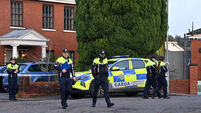‘Wrong’ to film Star Wars at Skellig Michael

Former manager has misgivings about using the historic site for commercial filming, says .
The site manager at Skellig Michael who worked on the island for more than 40 years has said filming scenes for two Star Wars movies there was “inappropriate” and claimed many visitors to the world heritage site were now more interested in its Hollywood depiction rather than its ancient history.
Skellig Michael was used for filming scenes for both The Force Awakens and The Last Jedi.
Documents released by the OPW under freedom of information back in 2014 showed some senior staff in the Office of Public Works had serious misgivings about the Unesco World Heritage Site being used to film scenes for the latest Star Wars movie, with one island guide querying whether there was a legal avenue to block the production.
Grellan Rourke retired from his position last summer after 41 years, although he is still working with the Office of Public Works on its archive.
He worked as site manager and team leader, and has now been succeeded by Fergus McCormack.
He recently gave a lecture at University College Dublin on the challenges of the Skellig site, including ensuring visitor safety and maintaining structures and afterwards told the Irish Examiner that visitors to the site these days are as likely to ask about Star Wars as they are to ask about the ancient monastery and the monks who constructed it.
During the Star Wars shoot, Mr Rourke was on-site to monitor the second stint and he said: “The whole thing was very professional but in a way, I think it is inappropriate to use a site like that for commercial filming.”
He said the use of technology can digitally recreate scenery and that this may have been a better option, adding: “You are not putting anything in jeopardy.”
He said the ancient structures on Skellig were just one aspect of the island, and that the nesting birds “added a layer of complexity”, particularly as access to Skellig is limited to between May and September and this overlaps with the nesting season.
“We do have a policy in the OPW in relation to education and knowledge and there is a protocol for people making or shooting a video or film and we would encourage that [using those protocols].
“When we were looking at the whole thing our concern at the time was more to make sure there was no damage.
“In hindsight, what was equally important was the impact of the film — that has been an issue in that Star Wars fans are much more organised than archaeologists and historians and they are booking well in advance.
“The majority going out there are more interested in the Star Wars aspect of it.
“When guides are giving the talks, a lot of questions relate to Star Wars and not the site itself.
“We still have the same limits on numbers [visiting] but because there is such demand, visitor numbers have risen.”
Mr Rourke said that while the daily limit is still 180 visitors a day, due to increased demand all boats making the trip are now at full capacity, meaning they carry 12 passengers per trip, rather than being less full as would have been the case in the years prior to Star Wars being shot there.
“They are now working the system to capacity,” he said, adding that “last year’s numbers will probably be the highest ever, possibly.

“We are working with the boatmen to bring them [visitors] out on a more phased basis.
“The aftermath of the filming has caused these sorts of issues. It will go on for a few years but hopefully it will settle down.”
Mr Rourke said Unesco did not express any dissatisfaction over its use in Star Wars.
However, he said the use of the island in the films may have resulted in a change in people’s perceptions regarding a world heritage site.
“It’s sad in one way, the real history of the place, over 1,400 years, that the real history is set to one side and the more recent make-believe is to the fore.”
He recalled a year in the mid-‘80s when the island was closed completely to visitors as necessary excavations and structural works were carried out.
He said in more recent years repair work has been continuing on the island’s lighthouse road.
Mr Rourke said another two seasons may complete work on the upper lighthouse, which is effectively unchanged since its construction in the 1820s and is already under OPW ownership.
He said this will add a whole new visitor attraction to Skellig Michael, and that discussions are continuing between the OPW and the Commissioner for Irish Lights over the possible transfer of the lower and newer lighthouse on the island to the OPW, so that it could be used by researchers and those working on the island, instead of timber huts currently in use and which could be removed.

“The idea would be the OPW would take it over,” he said.
“When we finish the upper lighthouse road and lighthouse it will add another dimension to Skellig Michael.
“There is agreement in principle the OPW will take it over, but the nitty-gritty of negotiations will need to be done,” he said.
However, he said this would mean visitors more likely having to choose between either the ancient structures or the lighthouse, as doing both in one day would prove difficult.
Mr Rourke also said climate change was having something of an impact on Skellig, in that it has seen two rockfalls in recent years, having had just one in recent memory prior to that.
“There are probably going to be more of these because of rainfall,” he said. “We have to be very vigilant.”
He said intensive safety checks are conducted to make it as safe as possible for visitors — “so far, so good, but you can’t be 100% sure of everything”.
While storm surges may present a difficulty, he said Skellig’s elevated and rocky aspect meant it was likely to withstand anything else the weather could throw at it.
“Our view is that this site will be open in 100 years’ time for people to visit it.”












